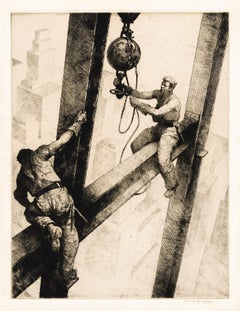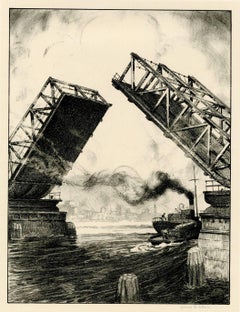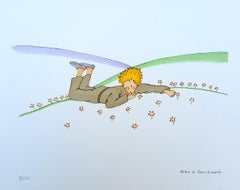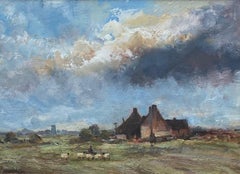James Allen Art
to
4
4
3
1
Overall Height
to
Overall Width
to
4
3
1
1
1
1
1
1
1
1
1
4
4
4
6,997
3,348
2,513
1,213
2
2
Artist: James Allen
'Spiderboy' — 1930s American Realism, New York City
By James Allen
Located in Myrtle Beach, SC
James Allen, 'Spiderboy', 1937, etching, edition 40, Ryan 86. Signed in pencil. A superb, richly-inked impression, on cream laid paper, with full margins (1 1/4 to 2 7/8 inches). A s...
Category
1930s American Realist James Allen Art
Materials
Etching
'The Connectors' — 1930s American Realism, New York City
By James Allen
Located in Myrtle Beach, SC
James Allen, 'The Connectors', 1934, etching, edition not stated, Ryan 66. Signed in pencil. A superb, richly-inked impression, on handmade, cream laid paper, with margins (1/2 to 1...
Category
1930s American Realist James Allen Art
Materials
Etching
The Trench
By James Allen
Located in Fairlawn, OH
Signed and annotated in pencil
Edition: 30
Provenance:
Frac Teck Services, Ft. Worth, TX
Part of a series of 12 images commissioned by United States Foundry Company in 1937.
Not...
Category
1930s James Allen Art
Materials
Lithograph
The Bridge
By James Allen
Located in Fairlawn, OH
Signed in pencil l.r., titled lower left edge of sheet
Reference: Not in Ryan
Note: Extremely rare. No impressions can be found in the Smithsonian American Art Museum, Metropo...
Category
1930s James Allen Art
Materials
Lithograph
Related Items
The Little Prince crying in the grass
By Antoine de saint Exupery
Located in Saint Ouen, FR
Lithograph in colors from the original watercolors of Antoine de Saint-Exupéry for his book "The Little Prince".
Limited edition, printed on Arches BFK Rives paper 250g (required be...
Category
Early 2000s James Allen Art
Materials
Lithograph
Irwin D. Hoffman, El Jibaro -- Puerto Rico
By Irwin D. Hoffman
Located in New York, NY
This subject was published by Associated American Artists in an edition of 162.
In the AAA catalogue raisonné of publications, by Gail Windisch, Art for Every Home, it serves as the...
Category
1940s American Realist James Allen Art
Materials
Aquatint, Etching
Union Street, San Francisco
By Edith (Mark) Milsk
Located in San Francisco, CA
This artwork titled "Union Street, San Francisco" is an original etching on creme wove paper by American artist Edith (Mark) Milsk, 1899-1982. It is hand signed and titled in pencil by the artist. The plate mark (Image) size is 5.5 x 3.65 inches, framed size is 16.5 x 13.40 inches. Custom framed in a red Oak frame, with beige matting. It is in excellent condition.
About the artist:
Edith Milsk...
Category
Mid-20th Century American Realist James Allen Art
Materials
Etching
Winter Tracery (Milford Connecticut)
Located in San Francisco, CA
This artwork titled 'Winter Tracery (Milford Connecticut)" is an original drypoint etching by noted American artist Philip Kappel, 1901-1981. It is hand signed and titled in pencil by the artist. The plate mark (Image) size is 9 x 12 inches, framed size is 17.25 x 21.25 inches. Custom framed in a wooden light grey frame, with light grey matting and black color fillet. It is in excellent condition.
About the artist:
Philip Kappel — painter, illustrator, printer, writer, and lecturer — was born on February 10, 1901 in Hartford, CT and died in 1981. Kappel is best remembered for his landscapes, portraits, figures, marine, lithography, and etching. He held a teaching position with H. B. Snell, Boothbay, ME Studios, 1923 and 1924. His addresses in 1929 were 500 Fifth Avenue in New York City and, for the summer, care of Philip Little, 10 Chestnut Street, Salem, MA; and in 1935, Sarasota, FL.
Kappel was a pupil of the Pratt Institute Art School in Brooklyn, NY and Philip Little (1857-1942) and held memberships with the North Shore Artists Association in Gloucester, MA; the Marblehead...
Category
Mid-20th Century American Realist James Allen Art
Materials
Drypoint, Etching
Maurice de Vlaminck - House in Rueil - Original Lithograph
By Maurice de Vlaminck
Located in Collonge Bellerive, Geneve, CH
Maurice de Vlaminck
Original Lithograph
Signed in the plate
1958
Title: House in Beauce
Dimensions: 22 x 27 cm
Reference: Catalogue raisonné Walterskirchen 275
Condition : Excellent
Maurice de Vlaminck (1876 - 1958)
Maurice was three years old when his family moved from Paris to Vésinet. He first pursued the same musical career as his parents, who were both musicians, leaving his home as a trained double-bass player in 1892 to move to Chatou near Versailles. After absolving his military service in Vitré Maurice Vlaminck worked as a musician until he accidentally met André Derain in 1900.
It was Derain who kindled Vlaminck's artistic ambitions. He decided to become a painter and rented an old hut in which he and Derain shared a studio. A crucial turning point in Vlaminck's artistic development was a visit to a van Gogh exhibition...
Category
1950s Impressionist James Allen Art
Materials
Lithograph
H 8.67 in W 10.63 in D 0.04 in
"Paris de ma fenêtre" 1969-1970 Paris from My Window - Color lithograph
By Marc Chagall
Located in Rancho Santa Fe, CA
Marc Chagall
"Paris de ma fenêtre"
1969-1970
Lithograph in colors on Arches paper
32.5 x 23.75 inches (image size)
39.5 x 27.5 inches (sheet size)
Edition of 50 + 25 AP
Signe...
Category
1960s Modern James Allen Art
Materials
Archival Paper, Lithograph
Portico D' Ottavia e Pescheria, Rome Italy. Tinted lithograph, Felix Benoist
By Felix Benoist
Located in Melbourne, Victoria
'Portico D' Ottavia e Pescheria'
Tinted lithograph by Eugene Ciceri after Felix Benoist (1813-1881), with figures by Bayot. From a French series titled 'Rome dans Sa Grandeur', cir...
Category
Late 19th Century Victorian James Allen Art
Materials
Lithograph
H 13.59 in W 19.69 in
Basilica di St Maria Maggiore, Rome, Italy. Tinted lithograph, Philippe Benoist
By Philippe Benoist
Located in Melbourne, Victoria
'Basilica di St Maria Maggiore. Veduta della facciata principale'
Tinted lithograph by Philippe Benoist (1813-1881). From a French series titled 'Rome dans Sa Grandeur', circa 1870...
Category
Late 19th Century Victorian James Allen Art
Materials
Lithograph
"Lorenzaccio" by Alphonse Mucha from Les Maitres de l'Affiche
By Alphonse Mucha
Located in Hinsdale, IL
Alphonse Mucha
"Lorenzaccio, a play in five acts and an epilogue by Alfred de Museet"
Plate #114
Image Size: 15" x 11"
1896
Alphonse Mucha was born in Southern Moravia on July 24, 1860. At the age of seventeen the artist left his home, to work as a painter of stage decorations...
Category
1890s Art Nouveau James Allen Art
Materials
Lithograph
H 23 in W 14.5 in D 1 in
Guillaume Corneille 1948 Aquatinte / eau forte
By Corneille
Located in Saint Ouen, FR
Guillaume Corneille
1948
Aquatinte/ eau forte
Proof of artist
Signed, dated and noted PA (artist’s proof) from the artist’s hand to the crayoN
Print run 125 copy
Laid paper with wate...
Category
1980s Modern James Allen Art
Materials
Lithograph
Chasseurs D'Afrique, Armee de Ligne lithograph pub. Lemercier 1861
By Édouard Armand-Dumaresq
Located in Paonia, CO
Chasseurs D’Afrique shows two bearded French soldiers from the Armee De Ligne or the Line Army series. There is an officer in the foreground with his arms across his chest and a...
Category
1860s James Allen Art
Materials
Lithograph
Sunday Morning
Located in Wilton Manors, FL
Sunday Morning. Title: Sunday Morning
Artist: Dox Thrash (American, Griffin, Georgia 1893–1965 Philadelphia, Pennsylvania)
Printer: Sam J. Brown (1901-1994).
Date: ca. 1939.
Medium: Drypoint
Dimensions: sheet: 12 5/8 x 10 5/8 in. (32 x 27 cm)
plate: 8 7/8 x 7 7/8 in. (22.5 x 20 cm)
This is the most heavily inked, atmospheric example known to exist. Unique, unsigned example from the collection of artist Samuel J. Brown.
Dox Thrash (1893–1965) was an African-American artist who was famed as a skilled draftsman, master printmaker, and painter and as the co-inventor of the Carborundum printmaking process.[1] The subject of his artwork was African American life. He served as a printmaker with the W.P.A. at the Fine Print Workshop of Philadelphia. The artist spent much of his career living and working in Philadelphia, Pennsylvania.[1]
Early life
Dox Thrash was born on March 22, 1893, in Griffin, Georgia.[2] He was the second of four children in his family. Thrash left home at the age of fifteen in search of work up north. He was part of the Great Migration (African American) looking for industrial work in the North.
The first job that Thrash got was working with a circus and a Vaudeville act. In 1911, at the age of 18, he moved to Chicago, Illinois.[3] He got a job as an elevator operator during the day, and used this source of income to attend school.[3] In 1914 he attended the School of the Art Institute of Chicago.[1]
In 1917, the United States declared war on Germany and entered World War I. In September 1917, at the age of twenty-four, Thrash enlisted in the army.[3] He was placed in the 365th Infantry Regiment, 183rd Brigade, 92nd Division, also known as the Buffalo Soldiers.[1] During combat, Thrash suffered shell shock and a gas attack, but was not permanently injured.
Career as an artist
Front cover of Dox Thrash: An African American Master Printmaker Rediscovered, by John Ittmann.
After having served in the war, Thrash qualified as a war veteran and enrolled in the Art Institute of Chicago with the support of federal funding.[3] After finishing his education, he traveled intermittently from Georgia to Chicago, Boston, New York, and finally Philadelphia, working odd jobs - experiences that provided him with subject matter to later paint. Settling in Philadelphia by 1925, he took a job working as a janitor. In his free time, he continued his art career and used his talent to create emblems, such as the one for the North Philadelphia Businessmen's Association, and posters in exhibitions and festivals, including the 2nd Annual National Negro Music Festival and the Tra Club of Philadelphia.[1] This gained him local recognition and opened doors for new artistic endeavors. By 1929, Thrash was attending nightly classes within these clubs, namely with Earl Horter of the Graphic Sketch Club, now known as the Samuel S. Fleisher Art Memorial.[3]
In 1937 Thrash joined the government-sponsored Works Progress Administration (WPA)'s Federal Art Project.[4] Through the WPA, Thrash began working at the Fine Print Workshop of Philadelphia.[5] At the Fine Print Workshop of Philadelphia, Thrash, along with Michael J. Gallagher and Hugh Mesibov, began experimenting and co-inventing the process of carborundum mezzotint, a printmaking technique.[1] Carborundum printmaking uses a carbon-based abrasive to burnish copper plates creating an image that can produce a print in tones ranging from pale gray to deep black. The method is similar to the more difficult and complicated mezzotint process developed in the 17th century. He used this as his primary medium for much of his career and created his greatest works with it. One of his first pieces employing this nascent technique was his anonymous self-portrait entitled Mr. X.
With this new technique, the three gained increasing recognition as they published more and more graphics within newspapers and featured more and more pieces within exhibitions. Their works often featured subtle commentaries about social and economic exploitation regarding the contemporary politics of the Great Depression and the Second World War. By 1940, Thrash, Gallagher, and Mesibov all began to gain attention in local circles for their carborundum prints, although the role that each artist played in the development of the process was left unclear.[6]
In 1960, Thrash participated in a show at the Pyramid Club, a social organization of Black professional men that held an annual art exhibit starting in 1941. Others on hand were Howard N. Watson, Benjamin Britt, Robert Jefferson and Samuel J. Brown Jr.
Thrash spent the later years of his life mentoring young African American artists. He died on April 19, 1965, in Philadelphia, Pennsylvania.[2] He was posthumously honored almost 40 years later in 2001 with a major retrospective, titled Dox Thrash: An African-American Master Printmaker Rediscovered, at the Philadelphia Museum of Art.[7]
Thrash's work was included in the 2015 exhibition We Speak: Black Artists in Philadelphia, 1920s-1970s at the Woodmere Art Museum.[8]
Relation to Alain Locke and the New Negro Movement
This section needs additional citations for verification. Please help improve this article by adding citations to reliable sources in this section. Unsourced material may be challenged and removed. (June 2022) (Learn how and when to remove this template message)
Alain LeRoy Locke (1885-1954) was an intellectual, professor and author who espoused that African Americans, specifically artists, to capture the personality, lives, and essence of their people in The New Negro. He explained “The Negro physiognomy must be freshly and objectively conceived on its own patterns if it is ever to be seriously and importantly interpreted. Art must discover and reveal the beauty which prejudice and caricature have overlaid.”[9] What Locke is expressing here is not only the call for black artists to overcome racial prejudices via positive artistic representations of blacks, but that the actual African American individual like Thrash portrayed the lives of fellow blacks, and had the power to propagate this idea of the New Negro, as Locke explains, “There is the possibility that the sensitive artistic mind of the American Negro, stimulated by a cultural pride and interest, will receive…a profound and galvanizing influence.”[10]
In his shadowy carborundum mezzotint Cabin Days, Thrash depicts a southern black family on the porch of their shack-like home in a rural landscape. The man, woman, and child, clutched tenderly to the female figure's breast, create an intimate scene highlighted by the bright cleanliness of the laundry hanging behind them. Placed in front of the drying laundry, they are framed by one aspect of the hard work accomplished during the day. Close to one another, staring collectively outward at the Southern landscape, they, and their laudable priorities of cleanliness and family, are made the bright focal point in the poor, unstable atmosphere. Such inner warmth is seemingly incompatible with the family's crooked and disheveled surroundings, and their fuzzy appearance with a lack of facial detail makes the scene into a general archetype for rural southern blacks living conditions and qualities. Thrash was referencing an experience common to thousands of black families in rural occupations at the turn of the 20th century, often forced into slavery-like tenant farming as their only means of livelihood in the racist South. The “uneven clapboards, leaning porch, broken shutter, and uprooted fence” are rife with instability, much like the post-slavery economic and social systems of the South, making it clear that for African Americans, “the house is not the home; rather, the figures on the porch represent family unity and continuity”.[10] In this way, Thrash is able to not only champion the positive qualities of blacks in the family setting but underscore this with a symbolic look at their disadvantaged situation, making it all the more impressive that they persevere. Thrash symbolically depicted harsh realities for the African American at this transitional point in history while conferring a sensitive rendering of their humanity, akin to any other race, despite its utter denial by American society.
Through softer tempera washes like A New Day, he literally and figuratively paints a picture of a black family transitioning from the South to the North during the Great Migration, making a hopeful, daring leap to attempt to be equal members of the society that has historically oppressed them. On the left side of the canvas lie muddled farm houses and plow handles, embodiments of their rural life of tedious hard labor behind them, fading to gray. Their hopeful gazes “…convey the optimism of the scores of African Americans who left the countryside to pursue better job opportunities, health care, and education in urban centers”.[6] The stance of the figures, with their chins raised in a dignified gesture towards cityscape ahead suggest a confidence and ambitiousness in their collective futures in this new northern industrial terrain. Even the child, clutched securely in the arm of the mother figure against her breast is not only serenely grinning, but calm enough to appear to gently doze, confident in that the journey ahead will result positively, poses no threat. The exposed arm of the woman is notable as well, being unusually thick and muscular, along with the general proportions of the kneeling father, who position on the ground appears not pleading but rather in a slightly exhausted, but upright gratefulness for the promise ahead. Thrash makes it clear that this family has traveled a long way, but is not depleted; rather they are strong and preparing for further hard work and hopeful success ahead. They are the quintessence of the New Negro, in that they are not only journeying forward to seize previously unobtainable opportunities that will enhance their lives, but the manner with which they hold themselves provokes a certain level of warranted respect for their humanity, from the viewer.
In fact it was the strength of his fellow African Americans that Thrash often emphasized, amongst other positive characteristics in the face of adversity in personal portraits. Through his carborundum print Life, he depicts a neatly dressed black girl reading...
Category
1930s American Realist James Allen Art
Materials
Etching
Previously Available Items
James Allen, Norfolk landscape with sheep and cottage
By James Allen
Located in Harkstead, GB
A delightful scene of a shepherd herding his flock before a cottage.
James J Allen
A shepherd and his flock before a cottage
Signed
Oil on board
4¾ x 6¾ inche...
Category
Late 20th Century Impressionist James Allen Art
Materials
Oil, Board
Teeming Ingots
By James Allen
Located in Myrtle Beach, SC
James Allen, 'Teeming Ingots', 1935, etching, edition c. 100, Ryan 88. Signed in pencil. A superb, richly-inked impression, in warm black ink, on cream laid paper, with full margins ...
Category
1930s American Modern James Allen Art
Materials
Etching
Big Bend
By James Allen
Located in Fairlawn, OH
Signed and annotated in pencil
Edition: 10
Provenance:
Frac Teck Services, Ft. Worth, TX
References And Exhibitions:
Part of a series of 12 images commissioned by Unit...
Category
1930s James Allen Art
Materials
Lithograph
James Allen art for sale on 1stDibs.
Find a wide variety of authentic James Allen art available for sale on 1stDibs. You can also browse by medium to find art by James Allen in etching, lithograph and more. Not every interior allows for large James Allen art, so small editions measuring 9 inches across are available. Customers who are interested in this artist might also find the work of Frank Henry Mason, Frank Wootton, and Paul H. Winchell. James Allen art prices can differ depending upon medium, time period and other attributes. On 1stDibs, the price for these items starts at $1,250 and tops out at $6,500, while the average work can sell for $3,475.
Artists Similar to James Allen
Questions About James Allen Art
- What is James Allen jewelry?1 Answer1stDibs ExpertMarch 13, 2024James Allen jewelry is an online retailer specializing in diamond engagement and wedding jewelry. Five experts from the jewelry industry — Oded Edelman, James Schultz, Michele Sigler, Dean Lederman and Roie Edelman — founded the site in 2006. James Allen is known for using only conflict-free diamonds that its experts hand select. On 1stDibs, shop an assortment of James Allen jewelry.







